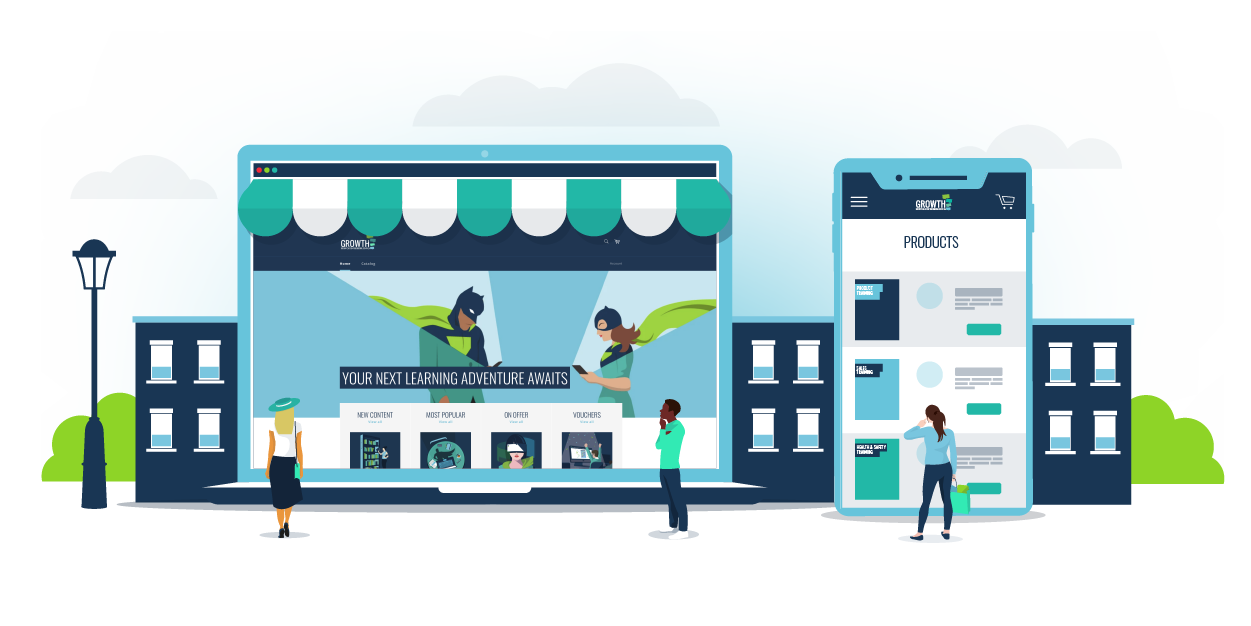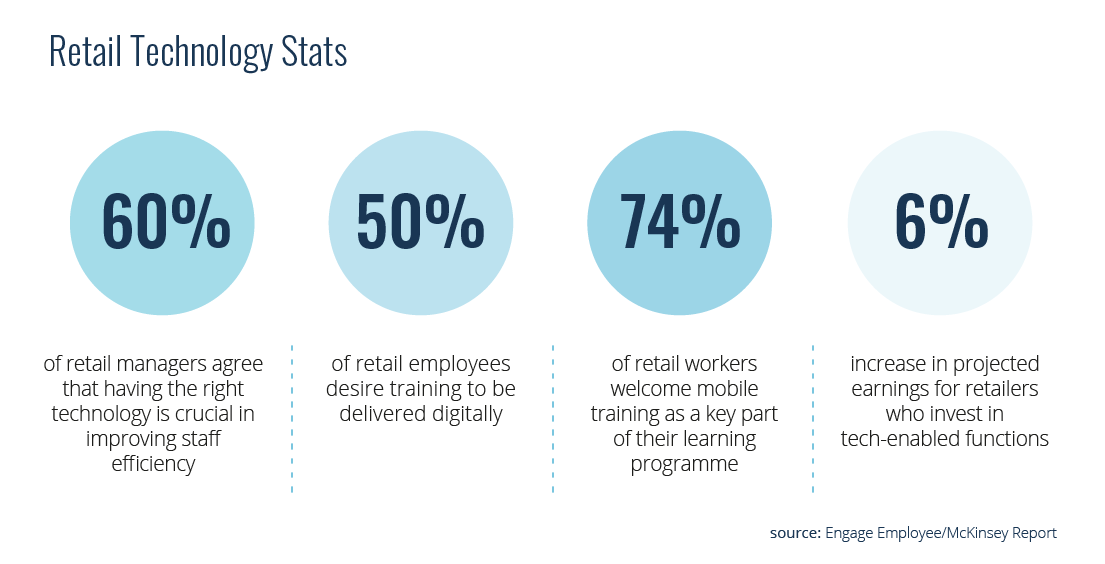
The retail landscape has always been dynamic, but recent years have seen an unprecedented acceleration of challenges. Unforeseen events and evolving consumer behaviours have forced retailers to adapt at a breakneck pace.
Luckily, this is a resilient industry. That’s evident from retail’s robust post-COVID recovery. Economist Intelligence forecasts healthy market expansion for 2025, projecting a 2.2% growth in volume (thanks to easing inflationary pressures). Furthermore, global retail sales are poised to reach $32.76 trillion by 2026.
But don’t pop the champagne just yet. The economic rollercoaster isn’t over and uncertainty still reigns. Thankfully, this constant change presents a significant learning opportunity for retail professionals. The ability to innovate and navigate complex challenges will be crucial for success in the years to come.
In this article, we’ll outline ten of the biggest retail challenges in 2025, exploring areas such as the evolving consumer landscape, supply chain disruptions, and the ever-growing importance of sustainability. This will arm you with the knowledge you need to thrive in this dynamic environment.
Without further ado, let’s begin!
1. Evolving Customer Demands

Retail customers change their preferences faster than Clark Kent in a phone booth. Just ask your Walkman, shell suits and the mullet (which actually now seems to have come back around). In order for retail to thrive, it must quickly adapt to evolving consumer shopping habits.
Today, customers expect a seamless omnichannel experience. They want to be able to research products online, order them for in-store pickup, or have them delivered to their homes, all with a few clicks. This is why 53% of brands are investing in tools that allow them to sell anywhere.
But customers’ evolving demands don’t stop there. Price sensitivity is on the rise, especially with inflation concerns. In fact, 46% of shoppers have switched brands recently, with price being the biggest driver for this change.
The rising demand for personalisation, transparency, and sustainability (which we’ll explore further) also create a complex challenge for retailers. It can sometimes feel impossible to keep up.
Top Tip: Study consumer habits and adapt and evolve as necessary. Ensure you capture feedback and share it with your team. Don’t forget, learning technology such as a learning management system can help support any resulting major business changes.
We also recommend nurturing a social learning community where each learner can provide examples of great customer service. Encourage your staff to participate by letting them share advice and anecdotes within your social learning platform.
2. Maintaining Brand Loyalty

Retention is king. A staggering 65% of a company’s revenue comes from repeat business, making customer retention and brand loyalty a critical focus for long-term success.
However, the rise of online shopping and the abundance of choices available to consumers make it easier than ever to switch brands.
Couple this with inflation and economic concerns and you have a recipe for real change. Loyalty programmes that rely solely on discounts may no longer be enough to retain customers.
After all, 90% of companies now have some form of loyalty programme in place. This makes it even harder for you to stand out. On the other hand, this also presents an opportunity for you to attract new customers to your business.
Top Tip: Now’s the perfect time to turn your staff into brand advocates. You should kickstart this process by clearly communicating your brand values. This is something that 63% of organisations fail to do effectively.
You can beat this statistic by implementing an engaging learning platform. This will help your staff to get up to speed with your brand’s mission, vision, and values. The sooner you share this information, the sooner you’ll create an army of advocates ready to live your brand values.
3. Improving Staff Efficiency

The success of every storefront hinges on a skilled team of retail professionals. These individuals are experts at building rapport and guiding customers towards satisfying purchases.
However, as with any other profession, regular training is needed to keep them at the top of their game. This need is often exacerbated by staff shortages. Indeed, 74% of retailers expect shortages in customer-facing positions in the coming year.
Unfortunately, traditional retail training methods are a bit like watching a Transformers movie — they’re time-consuming, dull and disappointing. You also have to contend with the opportunity cost and hassle of having managers leave their stores to attend these bore-a-thons.
Top Tip: Cater to the needs of your modern employees by deploying microlearning through a mobile learning solution. This makes information quicker and easier to digest. The mobile approach also helps to make learning more convenient and accessible.
For example, L’Oréal Travel Retail uses Growth Engineering Learning App to support Beauty Advisors across Asia Pacific. This has resulted in 18,400+ engagements per day, a 30% reduction in training costs, and a 20% boost in sales revenue in targeted territories.

4. Attracting & Retaining the Right Hires

Retail has always dealt with the challenge of high turnover rates. In fact, as things currently stand, there are two open positions for every unemployed worker. Estimates suggest that the retail industry would need to hire at least one million more workers to deal with these shortages.
At the same time, these businesses are also finding it hard to attract hires with the right skill sets. A McKinsey report shows that whilst technological skills will increase dramatically, physical, manual and basic cognitive skills will decrease by 24% by 2030.
This makes the recruiting process even tougher. Indeed, another McKinsey report shows that 83% of retailers are struggling with recruiting the right people. This means you’ll need to get more from your team, or find a way to automate certain processes.
Top Tip: Candidates, especially the younger ones, seek roles that resonate with their values. You should take care to communicate your brand identity from the outset, demonstrating how it connects with their career aspirations and personal values.
This investment is crucial. 45% of millennials say they would quit their job if they didn’t have a clear career pathway. Thankfully, by making professional development a core focus, you can incentivise managers to support their employees’ growth within your organisation.
5. Upskilling Staff

Technology is rapidly redefining the customer experience in retail. From automated checkout lanes to AI-powered recommendations and chatbots, retailers are embracing a wave of innovation that’s transforming how consumers shop.
Unfortunately, many retail workers fall short of the digital skills required to support and deliver these innovations. According to the Retail Times, digital skills are now required in 79% of retail jobs. Unfortunately, retail workers have the ‘lowest levels‘ of essential digital skills.
This widening skills gap is hindering retailers’ ability to deliver on customer expectations and build successful omnichannel businesses. This ultimately translates to lost sales opportunities, frustrated customers, and a struggle to compete in an increasingly digital landscape.
Top Tip: Invest in training programmes that equip employees with the skills needed for success in the digital age. These programmes could focus on areas like data analysis, social media marketing, and omnichannel fulfilment.
You should also consider pairing experienced employees with new hires to provide guidance and support. After all, mentorship programmes foster knowledge transfer and help new employees to develop essential skills on the job.
6. Engaging & Onboarding Talent

Retail is in the grips of an engagement crisis. In fact, a startling 41% of retail workers ‘hardly ever’ look forward to going to work. This contributes to the industry’s high turnover rate. While the average employee turnover across all US industries sits at around 19%, retail’s rate exceeds 60%.
Many retail positions require long hours, unpredictable schedules, and working weekends and holidays. This can make it difficult for employees to maintain a healthy work-life balance. Some retail jobs may also offer limited opportunities for advancement or skill development.
By understanding these causes of disengagement, retail businesses can develop strategies to improve their work environment, invest in their employees, and create a more engaging experience for their workforce.
Top Tip: Don’t just give your people a welcome pack. Find exciting ways of communicating your culture, values, and goals from the very beginning. You should also seek to deploy gamification in your engagement strategy.
Using game mechanics within your learning platform is a great way to encourage your learners to keep coming back for more. For example, why not use experience points, badges and leaderboards to incentivise learner activity?
7. Staff Health & Mental Wellbeing

Economic turbulence has forced many retailers to adopt stringent cost-cutting measures to maintain competitiveness. This often translates to staff reductions, placing increased pressure on remaining employees.
The cost of living crisis has also led to an increase in frustration from customers. According to the USDAW, a shocking 90% of retail workers have experienced verbal abuse in the past year, and 64% have been threatened by a customer.
Is it any wonder that 91% of line managers have seen an increase in mental health issues among their staff? Likewise, it’s not surprising that 1 in 5 retail workers want to leave the industry. After all, 28% of these staff members say that they do not get enough mental health support from their employers.
From all these dismal stats, one thing is clear. Retail leaders will need to step up when it comes to improving their staffs’ wellbeing. In turn, they will be rewarded with happier workers, which will ultimately result in business growth.
Top Tip: Building a compassionate and positive work culture is key to employee wellbeing. Neuroscience suggests that social learning activities are a powerful tool for achieving this. After all, social learning fosters empathy and trust among colleagues, which are contributors to a positive work environment.
Modern learning platforms often integrate social learning features like discussion forums and social feeds. These features go beyond traditional eLearning by fostering collaborative learning and knowledge sharing among employees.
8. Improving Customer Experience

The retail landscape has undergone a dramatic transformation. Today’s consumers enjoy unparalleled convenience, with virtually anything just a click away. In fact, by the time you get to the end of this sentence, about three hundred Amazon orders and deliveries will have been fulfilled.
However, the ease and convenience of online shopping has had a huge impact on the high street. According to UBS analysts, e-commerce disruption could close as many as 45,000 retail stores in the next five years. This process has already started. US retailers shut a total of 5,500 stores in 2023.
But brick and mortar stores shouldn’t despair just yet. A recent report shows that shoppers’ preference for in-person shopping remains undiminished in the face of e-commerce competition. Customers still love an in-store experience, as this lets them interact with products before purchasing them.
More importantly, today’s shoppers expect a seamless customer experience across all touchpoints. Whether in-store or online, customers expect to feel connected to a brand. In fact, 86% of customers say they’re willing to pay more money for a better customer experience.
Top Tip: Retailers must now equip their staff with the skills necessary to excel at customer engagement across all touchpoints. This will help to differentiate you from the online e-commerce giants.
To achieve this, you’ll need to provide comprehensive training that helps staff to understand the entire customer journey, from online browsing to in-store interactions and post-purchase support.
9. Walking the Sustainability Tightrope

Consumer expectations for sustainable practices are rapidly changing the retail environment. Today’s shoppers are increasingly environmentally and socially conscious, and they expect their favourite brands to be the same.
In fact, 32% of shoppers switched brands because of their sustainability practices in 2023. We are living in an age where consumers have easy access to information about a company’s sustainability efforts. Social media and online reviews readily expose greenwashing and hold brands accountable.
This presents a significant challenge for retailers who must now navigate a tightrope between meeting these evolving expectations and maintaining profitability in a challenging marketplace. Retailers must also avoid exaggerating their sustainability efforts and provide clear and transparent messaging.
Top Tip: Openly communicate sustainability efforts, challenges, and goals. Highlight partnerships with responsible businesses and provide clear information on product materials and sourcing.
You should also take steps to empower your retail workforce with knowledge about your sustainability initiatives. This fosters employee buy-in and equips them to confidently communicate your efforts to your customers.
10. Preparing for Our AI Future

Even as the future remains uncertain, there is something we can all agree on. The retail industry will continue to evolve. Retailers left and right are in an innovation frenzy. They are now in a race to see who can create the best and most engaging shopping experiences.
US stores such as Lowe’s are developing immersive technologies to revolutionise the customer experience. Examples include VR rooms that allow customers to virtually visualise their home improvement projects.
However, the most transformative force shaping the future of retail is artificial intelligence (AI). In fact, according to Statista, 73% of retailers are already using some form of AI. After all, it helps to streamline operations, automate key processes, and ultimately reduce costs.
Imagine the impact you’d see from using AI to optimise inventory management, reduce stockouts, minimise excess inventory and improve overall supply chain efficiency. This would revolutionise your demand forecasting and make your business more competitive than ever.
Top Tip: Constant innovation is required to remain competitive in this fast-paced and dynamic industry. However, before you dive into specific technologies, you should identify areas where you will be able to make the most impact.
Artificial intelligence has the power to personalise your customers’ experience, optimise inventory management, and streamline back-end operations. Start by implementing AI in a specific area, to help assess the technology’s impact and prepare for a larger-scale rollout.
Final Words
The retail landscape has weathered numerous storms over the years, with some challenges remaining stubbornly persistent. From economic uncertainty and staffing difficulties to ever-evolving customer needs, retailers must be adaptable and innovative in order to thrive.
By embracing new technologies like AI, fostering a positive work environment, and prioritising customer engagement, retailers can build a future that’s not only sustainable, but also delivers exceptional experiences for the consumers they serve.
Growth Engineering’s high impact solutions offer a seamless learning experience across all platforms. This includes an LMS, mobile app and authoring tool. What’s more, our award-winning expertise in neuroscience, gamification, and social learning will keep your retail learners engaged through and through!
Need more training inspiration? Download our 150 Learner Engagement Tips now!









